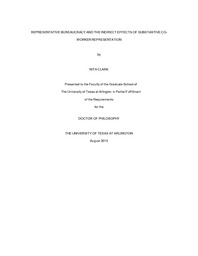
ATTENTION: The works hosted here are being migrated to a new repository that will consolidate resources, improve discoverability, and better show UTA's research impact on the global community. We will update authors as the migration progresses. Please see MavMatrix for more information.
Show simple item record
| dc.contributor.author | Clark, Nita | en_US |
| dc.date.accessioned | 2015-12-11T23:20:10Z | |
| dc.date.available | 2015-12-11T23:20:10Z | |
| dc.date.submitted | January 2015 | en_US |
| dc.identifier.other | DISS-13322 | en_US |
| dc.identifier.uri | http://hdl.handle.net/10106/25387 | |
| dc.description.abstract | The theory of representative bureaucracy has been suggested as an equity oriented tool that could work to alter the negative aspects of majority rule. Ongoing debates over the best way to ensure and enhance equity for underrepresented groups continue to question the value of representative bureaucracy as it has concentrated on passive (descriptive) and active representation. Such representation where administrators look like the clientele they are serving and subsequently work to generate outcomes for those clients certainly has value. However it is not a certainty that a bureaucrat sharing a similar traits as the group being served (passive representation) will inherently work for policy outputs for groups that share those characteristics (active representation). Questions persist in regards to policy outputs and outcomes, and whether it is purely minority administrators who are facilitating them. The weakness of passive and active representation is that these mechanisms fail to recognize the role that administrators not sharing certain traits as the public they are serving may play in generating equity. Additional research was needed to determine what role indirect representation, which is representation from bureaucrats outside the group being served, played in facilitating substantive representation. The significance of this research is that it filled a lacuna within the representative bureaucracy literature by testing the saliency of indirect substantive co-worker representation. This was done by determining if co-workers of black bureaucrats (in this case indirect sources of representation) played a positive role in Black student performance outcomes. Additionally this dissertation aimed to evaluate the influence of minority (Black) bureaucrats on their (Hispanic and White) co- workers in facilitating positive substantive representation for Black student performance. This was one of the first studies to look at co-worker representation and its role and value in generating substantive policy outcomes for Black students. To do this, this dissertation went beyond traditional studies in representative bureaucracy in that it employed quantitative data from the Texas Education Agency and qualitative data from interviews with 16 Black high school teachers (eight from higher economically disadvantaged schools and eight from lower economically disadvantaged schools). The results found that an increasing percentage of Hispanic teachers had a positive effect on Black student performance outcomes for Black student dropout and college readiness percentage, and an increasing percentage of White teachers had a positive effect on the Black student performance outcome of college readiness adding value to the assertion that they can potentially play a valuable role in achieving equity. In contrast an increasing percentage of Black teachers had a significantly negative effect on Black students performance outcomes for Black students, related to Black student dropout, graduation, and college readiness percentage, a finding that is counter to the very theory of representative bureaucracy. However, the ability of Black teachers’ to generate positive outcomes for black students appears to be mediated by the economic circumstances of the students they teach. Particularly, a greater percentage of Black teachers are responsible for generating outcomes in higher economically disadvantaged (HED) schools, and it is in HED schools where the negative effects result. Furthermore, within HED schools Black teachers are inhibited by external environmental conditions and internal organizational norms that limit the extent to which they advocate for student outcomes as well as the outcomes that are prioritized. In this sense, the conditions under which Black teachers are expected to produce more equitable outcomes is in essence, inequitable. For example, Black teachers are more likely to work in economically disadvantaged schools and in these schools they may face a different set of priorities for which they work to generate favorable student outcomes. These outcomes may not be reflected in the traditional educational goals of preparing students for college or future education. Thus, while active representation may have value in generating more equitable representation, the theory is incomplete if the structural features of the policy environment, bureaucrats and clients are not also considered. This suggests that those seeking to employ active/sources of representation may be mitigated by mediating factors that serve to undermine them; however through broadening representative bureaucracy to emphasize substantive representation rather than simply active/direct representation, equitable outcomes can still be achieved. | en_US |
| dc.description.sponsorship | Casey, Colleen | en_US |
| dc.language.iso | en | en_US |
| dc.publisher | Public Administration | en_US |
| dc.title | Representative Bureaucracy And The Indirect Effects Of Substantive Co-worker Representation | en_US |
| dc.type | Ph.D. | en_US |
| dc.contributor.committeeChair | Casey, Colleen | en_US |
| dc.degree.department | Public Administration | en_US |
| dc.degree.discipline | Public Administration | en_US |
| dc.degree.grantor | University of Texas at Arlington | en_US |
| dc.degree.level | doctoral | en_US |
| dc.degree.name | Ph.D. | en_US |
Files in this item
- Name:
- Clark_uta_2502D_13322.pdf
- Size:
- 2.836Mb
- Format:
- PDF
This item appears in the following Collection(s)
Show simple item record


